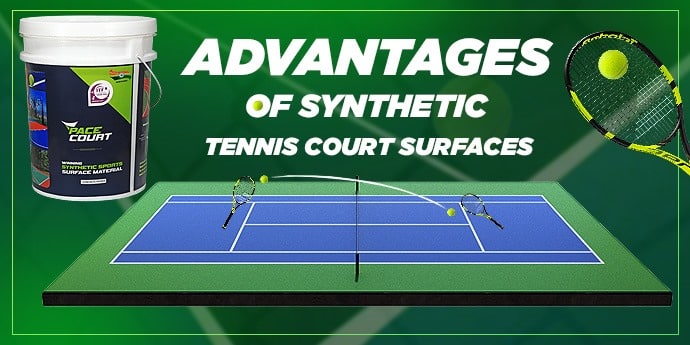When it comes to synthetic flooring, there are several options, each with its own set of benefits and applications. Among these, synthetic acrylic flooring has grown in popularity globally due to its remarkable performance and versatility. Acrylic flooring is a popular choice for sports facilities, business areas, and industrial uses because of its multiple benefits. In this blog, we'll look at the difficulties of synthetic tennis court surfaces for acrylic flooring and why it's unique among synthetic surfaces.
This detailed guide answers some important questions that may arise while considering acrylic sports flooring. We will provide extensive information to assist you make an informed decision.
We will discuss the following questions:
- Why choose hard court flooring for tennis
- What is Acrylic Flooring?
- What are the benefits and drawbacks of acrylic flooring?
- Why is acrylic flooring required on tennis courts?
- Why Most Players Want to Play on Acrylic Flooring
- What is the price of acrylic flooring?
By the end of this blog, you will have a good understanding of synthetic acrylic flooring, its benefits, potential pitfalls, and why it is becoming a more popular option for sports and other high-traffic courts. Whether you're a facilities manager, a sports fan, or just someone interested in innovative flooring options, this guide will provide you with the essential knowledge needed to evaluate and appreciate the value of acrylic flooring.

Why Choose Hard Court Flooring For Tennis
A hard court's uniform ball bounce and speed, low maintenance needs, adaptability to different weather, increased player safety, customizable surface textures, professional appeal as seen in major tournaments, and affordable installation and upkeep are just a few advantages of choosing hard court flooring for tennis.
India has seen a significant rise in tennis lovers and aspiring players as the sport has gained popularity. Tennis courts provide a platform for sportsmen to display their talents and love for the sport, from regional leagues to worldwide competitions. But what's often overlooked in tennis is the kind of flooring these courts are made of. The performance, longevity, and safety of the court can all considerably improved with the correct flooring. It affects the players' comfort and safety in addition to how the game played.
You may hear the term "many surfaces" when we discuss outdoor tennis courts since different tennis courts offer different playing surfaces, when we think about tennis courts, three types of flooring typically spring to mind.
Hard Court, Grass Court, and Clay Court
Although they require a lot of maintenance, grass courts are designed for a fast-paced, low-bouncing game. Then there are clay courts, which require a lot of maintenance and slow down play due to their high bounce. Additionally, it requires far less maintenance than clay and grass courts, which leads to the finest longevity and less cost.
Acrylic play surfaces are perfect for both recreational and professional play since they have a medium to rapid pace and a constant bounce. Because of their weather-resistant construction, they require less maintenance and offer a durable playing surface. Due to its adaptability and durability, acrylic flooring is becoming more and more popular in India as new tennis courts are built. Whether you are a tennis enthusiast looking to understand more about the game or a potential investor considering the construction of a tennis court, this guide provides comprehensive insights into the world of tennis court flooring, with a special focus on the advantages and specifics of acrylic surfaces.
What is Acrylic Flooring?
Acrylic flooring is a form of synthetic surface consisting of multiple layers of acrylic resin put in the base. There are two types of bases available: asphalt or concrete. The flooring that is installed on courts by 99% of Indians is acrylic, which is renowned for its durability, capacity to withstand heavy foot activity, and ability to resist a variety of weather conditions.
This surface is typically used for multipurpose courts, pickleball, tennis, basketball, volleyball, badminton, and skating rinks. Perfect bounce and a consistent surface are created by acrylic flooring, helping players maintain their winning ways and daily performance improvements.
The biggest advantage of using acrylic flooring is its low maintenance and economic effectiveness. Furthermore, these surfaces frequently come with a 3 years warranty, which ensures quality and longevity.
Benefits and Drawbacks of Acrylic Flooring
Benefits:
- Durability: Acrylic flooring is extremely durable and can withstand high foot traffic and a variety of weather conditions, making it suitable for outdoor construction.
- Consistent Performance: The surface produces a consistent ball bounce and speed, which is essential for sports such as tennis, ensuring fair play and dependable performance.
- Low maintenance: Compared to natural grass or clay courts, acrylic flooring requires little maintenance, saving time and money in the long run.
- Customization: Acrylic flooring can customized to fulfill specific aesthetic and performance requirements by choosing from a variety of colors and treatments.
- Player Safety: It is designed to lessen joint impact, hence preventing injuries and providing a comfortable playing experience.
- Eco-Friendly Options: Many acrylic flooring products are manufactured from recycled materials, which helps to promote sustainability.
Drawbacks:
Initial installation costs:
- Drawback: The initial cost of installing acrylic flooring may be more than for other options.
- Positive Point: Long-term savings on maintenance and repairs can balance the original cost.
Surface hardness:
- Drawback: Acrylic surfaces can be harder than other materials, such as clay, and may be less forgiving to players' joints.
- Positive Point: This hardness contributes to the surface's endurance and consistent performance, ensuring that it remains in good shape throughout time.
Temperature Sensitivity:
- Drawback: Acrylic flooring can become rather hot in direct sunshine, which may impact playing conditions.
- Positive Point: This problem can solved by using suitable shading techniques or using lighter colors that reflect sunlight.
Installation time:
- Drawback: The installation process can time-consuming since each layer of acrylic resin must properly cured.
- Positive Point: Once installed, the surface is ready for immediate use and offers long-term performance, making the wait worthwhile.
Limited Shock Absorption:
- Drawback: Compared to softer surfaces, acrylic flooring absorbs less shock.
- Positive Point: This feature makes the surface excellent for competitive play since it provides a rapid and consistent playing experience that is preferred in professional settings.
Why is acrylic flooring required for tennis courts?
Acrylic flooring is essential for tennis courts because it creates a controlled and uniform playing environment, which is necessary for both practice and competitive play. The surface's smooth and equal texture enables excellent ball control, allowing players to improve their skills effectively. This makes it an excellent alternative for facilities that hold frequent tournaments and require periodic cleaning of high-quality surfaces.
Why Most Players Want to Play on Acrylic Flooring?
Consistent Ball Response: Acrylic flooring provides consistent ball bounce and speed, which players like for more predictable play and greater performance.
Enhanced Footing: The texture of acrylic surfaces provides good traction, lowering the chance of slips and falls and letting players to move freely and rapidly on the court.
High-Performance Standards: Because acrylic courts are frequently used in professional tournaments, playing on these surfaces helps players adjust to the conditions they may encounter in competitive play.
Minimal Dust & Debris: Unlike clay courts, acrylic surfaces emit no dust or debris, resulting in a cleaner playing environment and fewer distractions.
Year-Round Playability: Acrylic courts are less impacted by seasonal fluctuations and may played all year, giving players additional opportunities to practice and compete.
Visual Appeal: The brilliant colors and smooth finish of acrylic courts add to their aesthetic appeal, producing an appealing and professional-looking atmosphere that players love.
Quick Recovery After Rain: Acrylic surfaces dry faster than other types of courts, allowing for a quicker return to play after a rainstorm, which is critical for maintaining a consistent training plan.
Customizable Hardness: The flexibility to modify the surface hardness to fit different playing styles and preferences makes acrylic flooring appealing to a wide variety of players, from recreational to professional.
What is the Price of Acrylic Flooring?
Acrylic flooring prices vary based on how many layers put. Here are the prices for two standard configurations, including materials and installation costs:
5-Layer: 50 INR per square foot
8-Layer: 70 INR per sq. foot
These prices represent the total cost of both the acrylic materials and the professional installation.
Download this PDF to learn more about 5 Layer and 8 Layer system
Acrylic flooring part of synthetic surface made from layers of acrylic resin applied over a prepared base, typically concrete or asphalt. It provides a durable, consistent, and low-maintenance playing surface ideal for tennis courts.
Acrylic flooring offers several advantages, including consistent ball bounce, low maintenance requirements, durability, quick drying times, and enhanced player safety. It is also customizable in terms of color and texture.
The installation time for an acrylic tennis court surface can vary based on the specific project requirements and weather conditions. Generally, it takes about 1 to 2 weeks to complete, including preparation, layering, and curing times.
The main difference is the number of layers of acrylic resin and coatings applied. A 5-layer system includes base, resin, color, and topcoat layers, while an 8-layer system adds more resin and color layers for increased durability, enhanced aesthetics, and better performance.
The cost of acrylic flooring varies based on the number of layers and specific project details. Typically, a 5-layer system costs around 50 INR per square foot, while an 8-layer system costs around 70 INR per square foot, including materials and installation.



